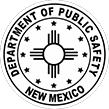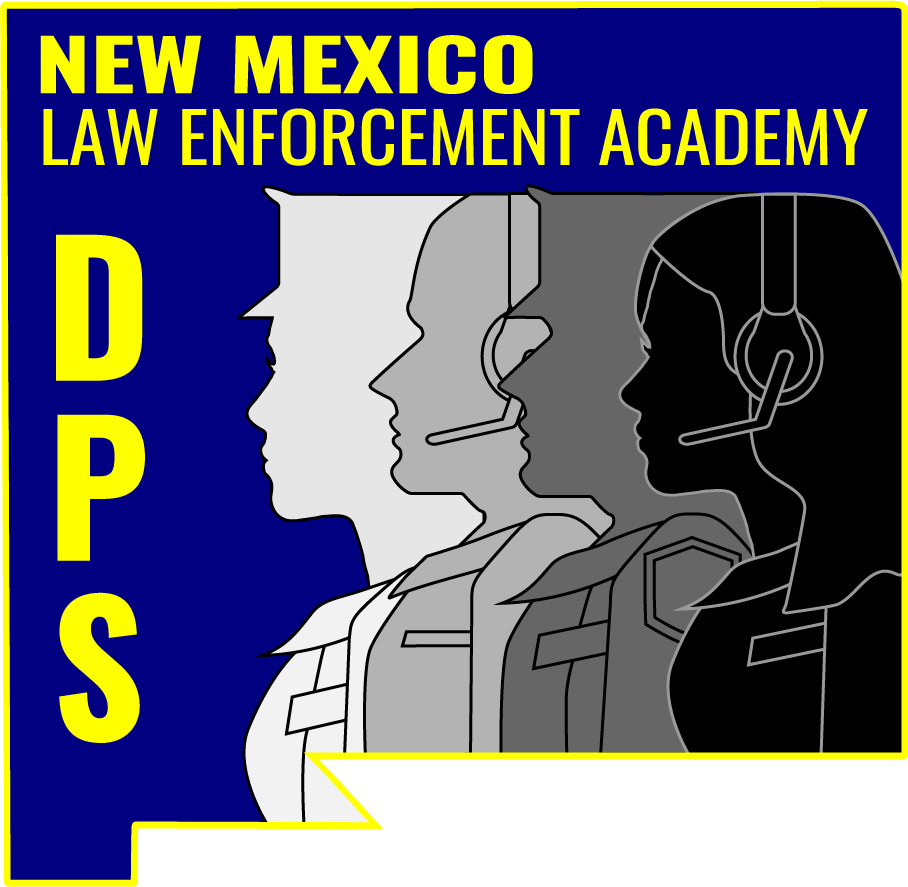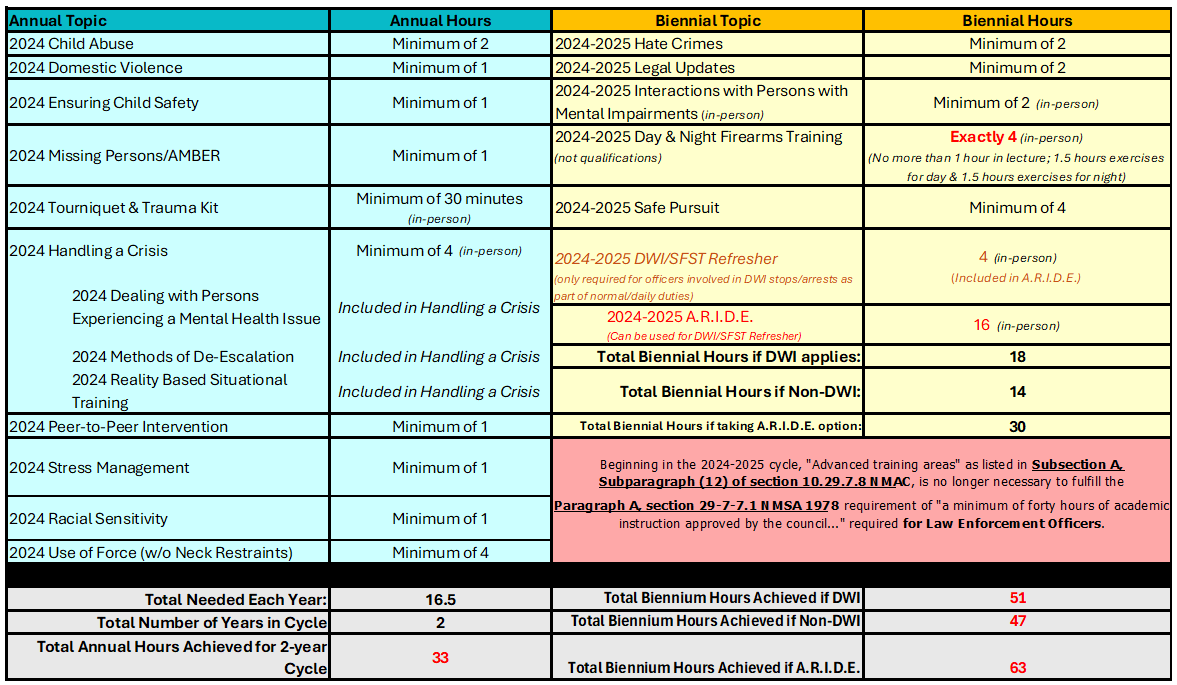In-service Training
- NMLEA Home
- In-service Training
- LECB
- NMLEA
- NMLEA Events Calendar
- Director's Page
- Basic Police Officer Training (BPOT)
- Certification By Waiver (CBW)
- Public Safety Telecommunicator
- In-Service Training
- Satellite Academies
- Albuquerque Police Department (APD) Training Academy
- Bernalillo County Sheriffs Office (BCSO) Training Academy
- Central New Mexico (CNM) Law Enforcement Academy
- Dona Ana County Sherriff's Office (DASO) Training Academy
- Las Cruces Police Department (LCPD) Training Academy
- New Mexico State Police (NMSP) Training Academy
- San Juan Criminal Justice Authority
- Southeastern New Mexico Law Enforcement
- Western NM University Police Academy
- Forms & Documents
- NM Law Enforcement Standards & Training Council
- NM Law Enforcement Officer Memorial
- NMSP
- Law Enforcement Support Services
- Budget Bureau
- Financial Management Bureau
- Law Enforcement Records Bureau
- Grants Management Bureau
- Programs
- Coronavirus Emergency Supplemental Funding (CESF)
- Community Oriented Policing Services Anti-Methamphetamine Program
- DNA Capacity Enhancement For Backlog Reduction (CEBR) Program
- Edward Byrne Justice Assistance Grant Program
- High Intensity Drug Trafficking Area Program
- Law Enforcement Mental Health and Wellness Act Program
- Motor Carrier Safety Assistance Program (MCSAP)
- NM Sexual Assault Kit Initiative Program
- Paul Coverdell Science Improvement Program
- Post-Conviction Testing of DNA Evidence to Exonerate the Innocent Program
- Prison Rape Elimination Act Program
- Project Safe Neighborhood (PSN)
- Residential Substance Abuse Treatment Program
- Support for Adam Walsh Act Implementation Grant Program
- Traffic Safety
- Victim of Crime Act - Victim Advocacy Program
- Waste Isolation Pilot Plant (WIPP)
- Funding Opportunities
- Grant Guidance and Resources
- Careers
- Programs
- Forensic Laboratory Bureau
- Information Technology
- Equal Employment Opportunity Bureau
- What’s Happening
- Careers
New Mexico Law Enforcement In-Service Requirements
In-service law enforcement training consists of at least forty (40) hours of academic instruction, approved by the council, for each certified police officer during each twenty-four-month period of employment or service. The first training course shall commence no later than twelve months after graduation from an approved basic law enforcement training program.
In-service telecommunicator training consists of at least twenty (20) hours of board-approved advanced training, including one hour of crisis management, including crisis intervention, confrontation de-escalation practicum and proper interaction with persons with mental impairments training, for each certified telecommunicator during each two-year period. The first training course shall commence no later than twelve months after graduation from a board-approved basic telecommunicator training program.
2024-2025 Reporting Requirements
All certified individuals shall provide proof of completing in-service law enforcement training requirements to the Director no later than March 1st of the year in which the requirements must be met.
Individuals obtaining certification within an even numbered year will be required to obtain one-half of the in-service training requirements. Individuals obtaining certification within an odd numbered year will be required to meet the next two-year in-service training requirement which will go into effect on January 1 of the succeeding even numbered year. The in-service training requirements are applicable in subsequent two-year cycles (one even number year and the subsequent odd numbered year constitutes a two-year cycle). Individuals transferring from one agency to another will carry with them the responsibility for in-service training.
Reporting Forms
In-service training reporting is due quarterly as required by §29-7-7.2 NMSA 1978. Agencies shall use approved NMLEAB forms for reporting purposes. Current approved reporting forms to report mandatory in-service training required by §10.29.7.8 NMAC and §10.29.7.9 NMAC, are:
2024-2025 In-Service Reporting Forms
- 2024 LEA 84: Annual Agency In-Service Training Report Law Enforcement Officer
- 2024 LEA 84A: Annual Agency In-Service Training Report Public Safety Telecommunicator
- 2024-2025 LEA-84: Biennium Agency In-Service Training Report Law Enforcement Officer
- 2024-2025 LEA-84A: Biennium Agency In-Service Training Report Public Safety Telecommunicators
- 2024 LEA 83: Annual Agency Firearm Re-Qualification Report
**These forms MUST be mailed to the NMLEA at the address listed on the top of the form NO LATER THAN March 1 of each reporting year (2024 is due 03/01/2025; and 2025 is due 03/01/2026).**
Using the Acadis® Portal to View & Complete the LEA-84 to Report Current Agency Compliance for the Biennium
Utilizing the “Career Role* Compliance” feature, Acadis® can help you easily identify which officers need to be listed on the Exception Report (pages 2-4) of the LEA-84. You may export the data results from the Portal page to a Microsoft Excel spreadsheet to submit as supporting documentation for inclusion with your LEA-84 affidavit to supplement the Exception Report and to provide the form’s requested List of Employees that the affidavit form certifies as having completed all required training.
This report dashboard will show you how many eligible employees are assigned to that Career Role* Requirement, how many have not fulfilled the requirement, and how many have completed the requirement. These numbers are listed under columns that display as clickable links that will provide a list of personnel in the agency assigned that requirement. If there is training that is missing from individual officer(s) on the Career Role* Compliance report, it will show what topic(s) your agency will need to focus on sheduling and which personnel should be sent to complete and report the training requirement to make sure that the officer isn’t listed as an exception and therefore in non-compliance.
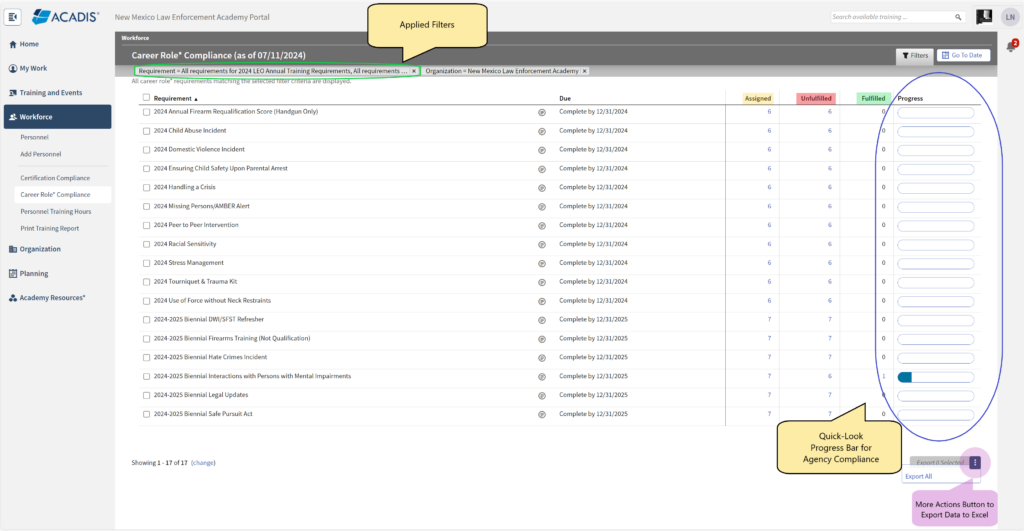
REMINDER:
Training Category and Accreditiation Number are CRITICAL for tracking eligible training, and only NMLEA accredited training (has valid NMLEA Accreditation Number) can be counted toward the required annual and biennial In-Service hours. Allowable comparable training is now available for each topic under the Curriculum Resources in the sections below on this webpage. If a course accreditation number is NOT listed under Comparable Training, then it DOES NOT fulfill the requirement.
Therefore, you should submit any completed training rosters or course completion certificates by first typing in the Accreditation number when “Reporting Completed Training” and selecting the resulting course fromt the drop-down menu. If an Accreditation Number is not in the drop-down, you MAY enter the training by using the “Entering my Own Training” and selecting “Mandatory Retraining (Biennium)” as the Training Category if a training submission has an NMLEA Accreditation Number, AND is NOT one of the specific in-service training categories listed below:
-
-
-
-
-
- Domestic Abuse
- Child Abuse Incident
- Ensuring Child Safety Upon Parental Arrest
- Handling a Crisis (includes Dealing with Persons Experiencing a Mental Health Issue, Methods of De-Escalation, and Reality Based Situational Training)
- Missing Persons and AMBER Alert
- Peer to Peer Intervention
- Racial Sensitivity
- Reality Based Sitiuational Training (usually included in Handling a Crisis, but some agencies have accredited this course separately)
- Stress Management
- Tourniquet & Trauma Kit
- Use of Force (w/out Neck Restraints)
- Safe Pursuit Act
- Detection, Investigation and Reporting of Hate Crimes
- Firearms – (Not Handgun Requalification Scores)
- Interactions with Persons with Mental Impairments
- Legal Update
- DWI/SFST Update or A.R.I.D.E. – only for officers who may be involved in the arrest of DWI offenders.
-
-
-
-
How To: Using the “Career Role* Compliance” page to view employee requirements status for biennium compliance by category
1. To view the the status of your agency’s employees within a given reporting timeframe, hover over the Workforce tab at the right of your Acadis® Portal (Shown below) and select the “Career Role* Compliance” page. This page will break down the completed training hours by annual and biennial training requirement.
![]()
2. By default, this page will show all current Career Role* requirements assigned to all personnel (if you employ both law enforcement officers and public safety telecommunicators, your screen should appear with all LEO and PST requirements – as shown in the example screenshot). By clicking the “Filters” button at the top-right of the page, specific requirements for the assigned Career Roles* can be applied. Below, you see the ability to customize the query results by requirement(s); more than one requirement can be selected as shown in the example screenshot below.
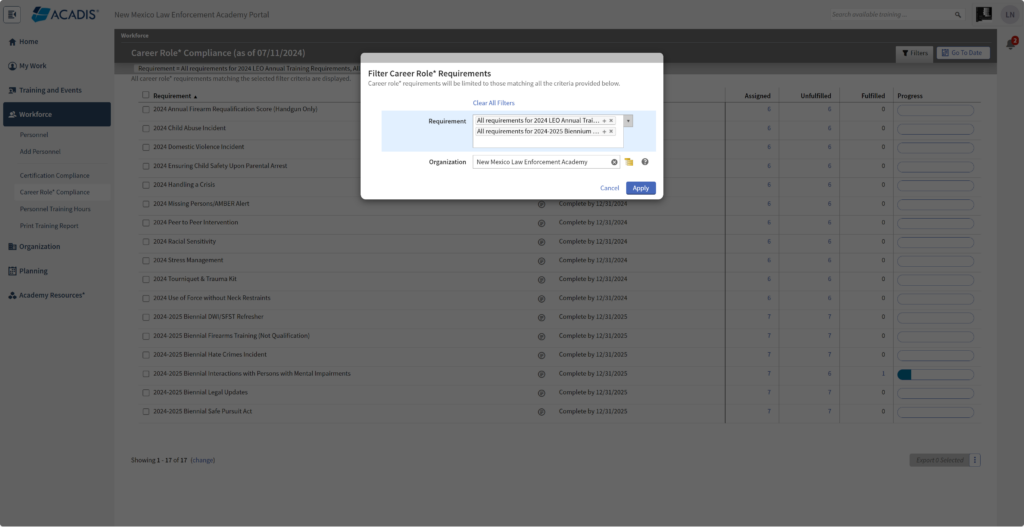
Beginning for the 2024-2025 In-Service cycle, the LEA-84 forms are now dated for the individual reporting year for reporting annual topics and for the biennial year 2024-2025 to report biennial topics. Agencies are required to report two annual forms and a biennial form, plus two annual firearms reporting (LEA-83) forms to be considered compliant with reporting and ELIGIBLE for Law Enforcement Retention Funds and Law Enforcement Protection Funds.
All Law Enforcement Agencies Reporting Officers MUST submit the following for the 2024-2025 training cycle:
2024 LEA-84 Annual In-Service Report for Law Enforcement Officers (Due no later than March 1, 2025)
2024 LEA-83 Annual Firearm Re-Qualification Report (Due no later than March 1, 2025)
2024-2025 LEA-84 Biennial In-Service Training Report for Law Enforcement Officers (Due no later than March 1, 2026)
2025 LEA-84 Annual In-Service Report for Law Enforcement Officers (Due no later than March 1, 2026)
2025 LEA-83 Annual Firearm Re-Qualification Report (Due no later than March 1, 2026)
The NMLEA recommends that agencies report biennium compliance this way as it is the BEST way to ensure that compliance has been met and can be validated by the NMLECB.
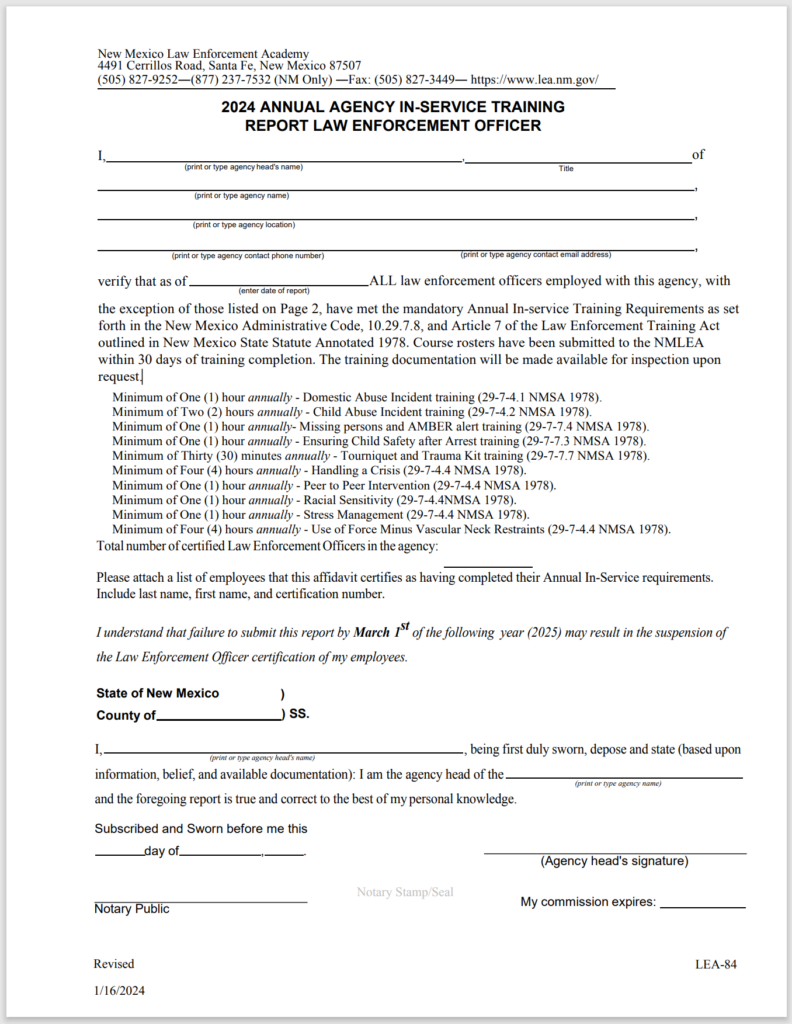
The statement in verifying that course rosters have been submitted to the NMLEA within 30 days of completion is fulfilled if the training has been submitted through the Acadis Portal and approved by NMLEA staff after reviewing the uploaded rosters or course completion certificates attached to the submission.

All original rosters or course completion certificates are mandated to be maintained by the instructor or individual student or their agency for a period as defined in the Functional Records Retention and Destruction Schedule (FRRDS) of the New Mexico Administrative Code (NMAC). The current citation for law enforcement training records is 1.21.2.943 NMAC. The statement “the training documentation will be made avaialble for inspection upon request” is referring to the original rosters and course completions certificates.
Execption Reporting and Make-up Training
Listing Officers as Exceptions and reporting non-compliance remediation trainings (make-up) is reserved for pages 2-4 of the form packet. Only if an agency has EXCEPTIONS to report and those individual’s subsequent make-up training to report, will they need to complete pages 2-4.
Complete page 2 using the example shown below. Use as many sheets of page 2 as needed to report all non-compliance officers that were shown in the Acadis® Career Roles Compliance monitor.
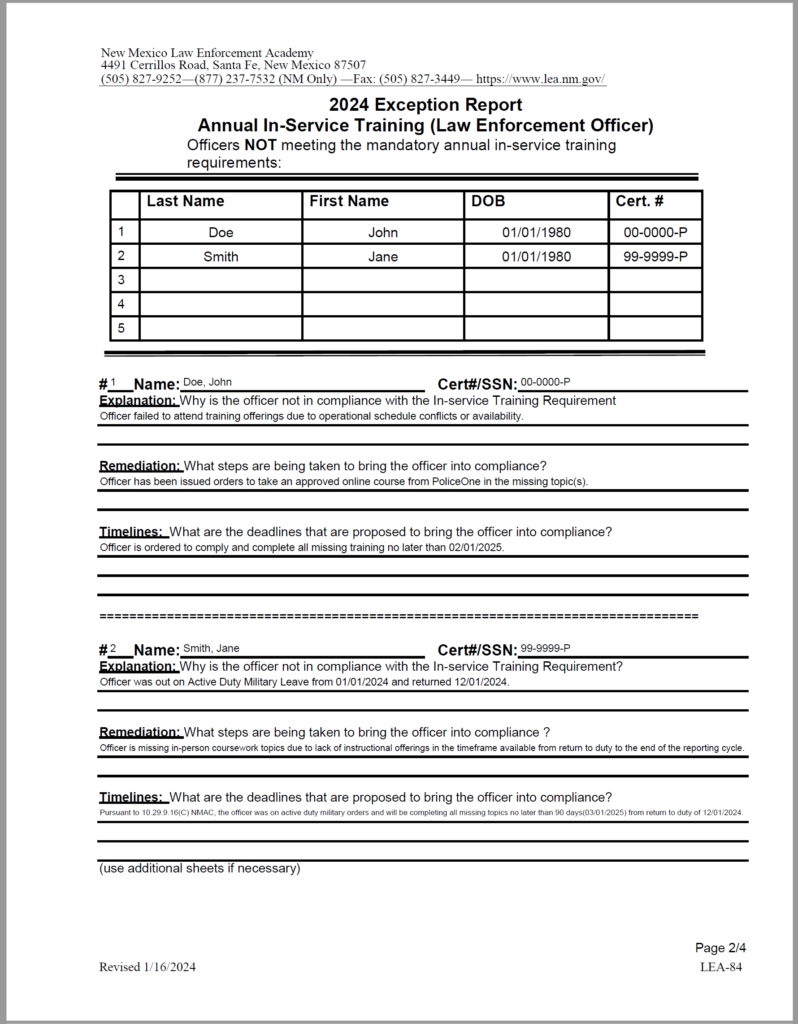
When reporting individual officers’ make-up training to bring them back into compliance, Agency Training Coordinators MUST attach pages 3-4 WITH the Report Completed Training submission uploaded to the NMLEA via Acadis® Portal. Including pages 3-4 assists NMLEA reviewing staff in identifying officers previously reported as out of compliance as being brought into compliance to provide their name and certification number to the NMLECB at their next regular meeting for renewal/reinstatement ratification. Be sure to not forget to attach the course completion certificate or roster for each training being reported! Use the example below to complete the reporting form(s) for make-up training for EACH execption listed officer.
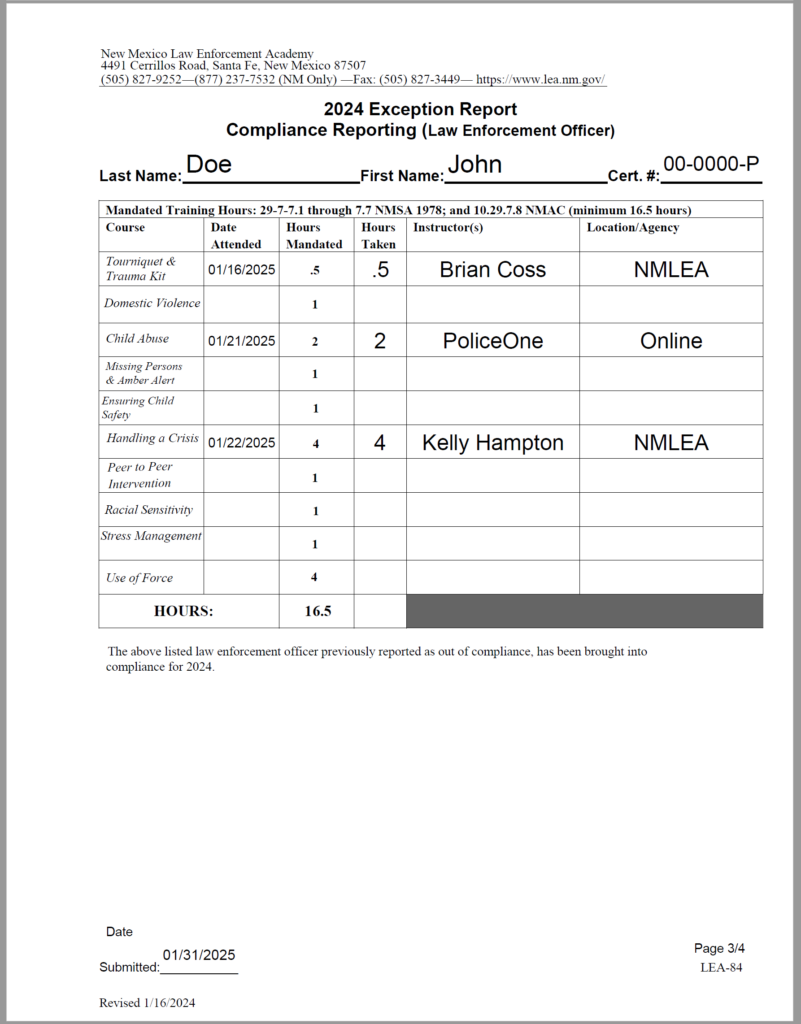
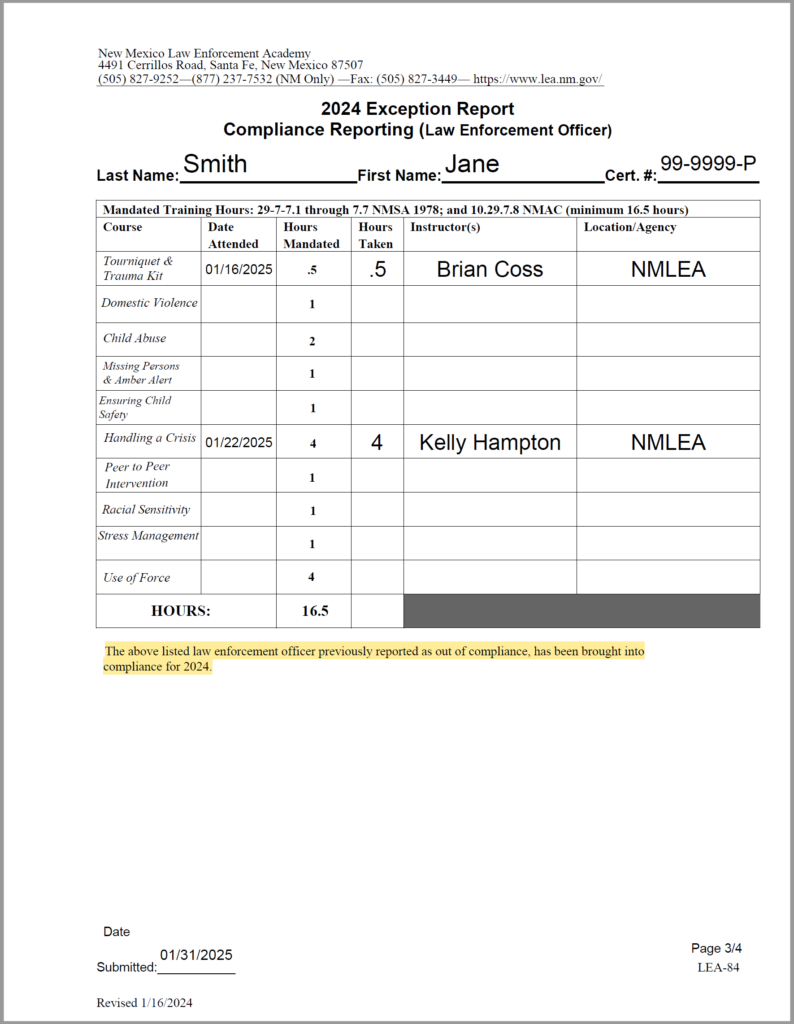
Complete page 4 for EACH individual officer being brough back into compliance and include with page 3 for all completed training submissions reported to the NMLEA via the Acadis® Portal. Reviewing NMLEA staff will document and note the officer and agency to submit to the NMLECB for reinstatement/renewal of certification, if a decertification due to non-compliance with In-Service requirements action has been taken against the officer’s certification.
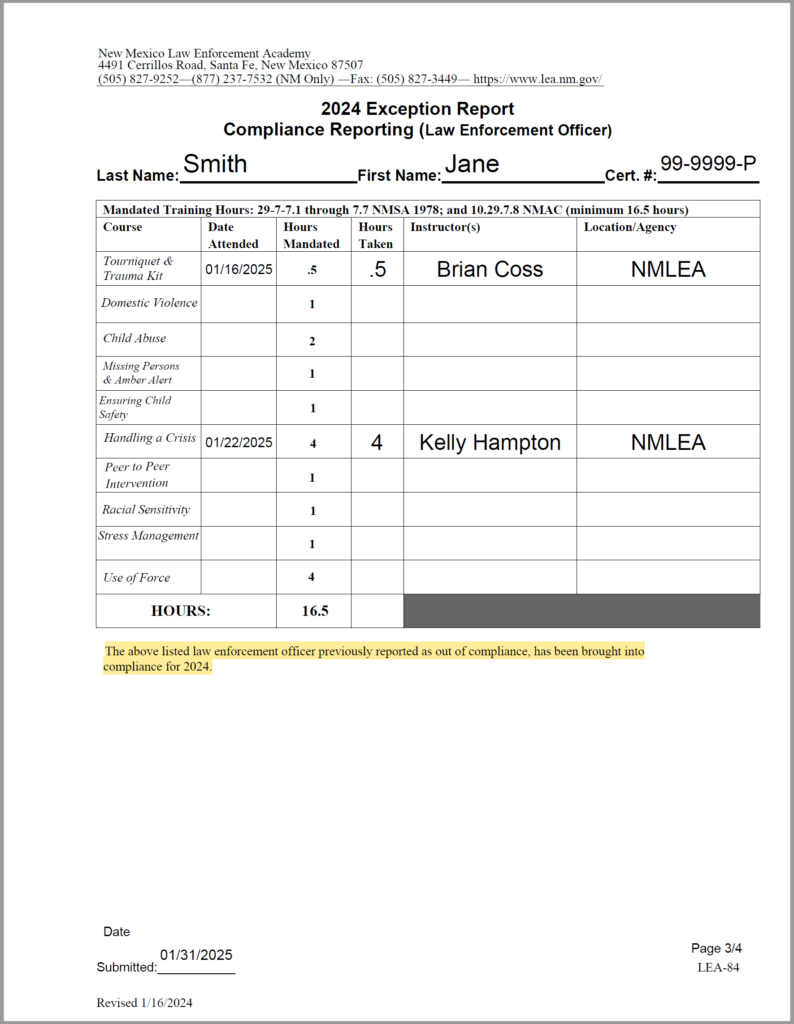
**These forms MUST be mailed to the NMLEA at the address listed on the top of the form NO LATER THAN March 1 of each reporting year (2024 is due 03/01/2025; and 2025 is due 03/01/2026).**
COMING SOON - How to video for completing the LEA-84 and LEA-83 Reporting Forms!
Coming soon in 2025 is an NMLEA training video on how to complete the LEA-84 and LEA-83 reporting forms due no later than MARCH 1st of each year. Ensure your agency is eligible to apply for LERF and LEPF monies and stay in compliance with reporting requirements with the NMLEA!
Changes to 2024-2025 Biennium Requirements
Effective January 1, 2024, the new statutory requirements of §29-7-4.4 NMSA 1978 and §29-7C-4.1 NMSA 1978 have been incorporated into the compliance reporting cycle. These topics are ANNUAL requirements, and will need to be taken once during the 2024 calendar year and once during the 2025 calendar year.
The NMLEA has broken-down the requirements in the following visualization tables to help understand the quantity and frequency of each specified required topic listed in the Law Enforcement Training Act (§29-7-et. al NMSA 1978).
Police Officer Requirements
Please note that due to the minimum total hours for all statute specified annual and biennial topics exceeding 40 hours, “Remaining training hours shall be in maintenance or advanced areas to meet the agencies specific needs” as described in §10.29.7.8, Paragraph A, Subparagraph (12) NMAC, is no longer necessary to fulfill the requirement, “In-service law enforcement training consists of a minimum of forty hours of academic instruction approved by the council for each certified police officer during each twenty-four month period of employment or service with a state or local law enforcement agency…” as prescribed by §29-7-7.1 NMSA 1978 for law enforcement officers.
Public Safety Telecommunicator Requirements
Please note that Public Safety Telecommunicators must still fulfill a minimum of 4 “Remaining training hours shall be in maintenance or advanced training areas to meet the agency’s specific needs and abilities of the telecommunicator” as described in §10.29.7.9, Paragraph A, Subparagraph (2) NMAC, by seeking NM Law Enforcement Certification Board-approved accredited courses pursuant to §29-7C-7 NMSA 1978.
New Mexico Law Enforcement Academy Board and Council Accredited In-Service Curriculum
The following training documents are provided for agencies to use to provide the required in-service training courses mandated by NM State Statute and/or NMLEA Board Rules. Each course has an accompanying NMLEAB Accreditation number.
The following courses are developed to be taught in-person (except Use of Force) and cannot be taught virtually at this time. These courses can only be taught by certified instructors with topic-specific instructor credentials:
- Handling a Crisis (general AND mental health instructor credentials required)
- Interactions with Persons with Mental Impairments
- Firearms
- Use of Force (not in-person, but specific instructor credential)
- Tourniquet & Trauma Kit
Agencies or vendors may develop and submit their own curriculum for accreditation utilizing NMLEAB form LEAB-86. Attendance must be documented within 30-days of course date, using NMLEAB form LEAB-86b or by submission approval through the Acadis® Portal.
Annual In-Service Training Curriculum
10.29.7.8 IN-SERVICE TRAINING CYCLE FOR LAW ENFORCEMENT OFFICERS & Instructor Certifications required to teach the In-Service Training
A. All New Mexico certified law enforcement officers shall receive a minimum of 40 hours of training bi-annually (every other year). Each two year in-service training cycle will begin on the first day of the subsequent even numbered year and conclude on the final day of the sequential odd numbered year.
(1) A minimum of four hours training shall be in safe pursuit pursuant to Section 29-20-3 NMSA 1978. – General Instructor Certification
(2) A minimum of one hour training shall be in domestic violence incident training pursuant to Section 29-7-4.1 NMSA1978, annually. – Domestic Violence Instructor Certification
(3) A minimum of two hours training shall be in the detection, investigation and reporting of a crime motivated by hate pursuant to Subsection B of Section 31-18B-5 NMSA 1978. – General Instructor
(4) For all officers who may be involved in the arrest of driving while intoxicated (DWI) offenders as a normal part of their duties, four hours training shall be in NHTSA approved standardized field sobriety testing (SFST) protocols or successful course completion of the NHTSA approved 16 hour advanced roadside impaired driving enforcement course. – DWI/SFST Instructor Certification
(5) A minimum of one hour training shall be in ensuring child safety upon arrest pursuant to Section 29-7-7.3 NMSA 1978, annually. – General Instructor Certification
(6) Four hours training of academy approved day and night firearms training on agency approved weapons systems including, but not limited to, duty handgun, backup handgun, shotgun, and rifle. No more than one hour training shall be classroom lecture. A minimum of three hours training, divided equally between day and night training, and shall consist of practical exercises using live fire, Simmunitions®, Airsoft® or other firearms training systems. Qualification testing may not be used as training to meet this requirement. – Firearms Instructor Certification
(7) A minimum of two hours training in child abuse incident training pursuant to Section 29-7-4.2 NMSA 1978, annually. – General Instructor/Child Abuse Instructor Certification
(8) A minimum of one hour training shall be in missing persons and Amber alert training pursuant to Section 29-7-7.4 NMSA 1978, annually. – General Instructor Certification
(9) A minimum of two hours training shall be in academy accredited interaction with persons with mental impairments training pursuant to Section 29-7-7.5 NMSA 1978. – Interactions with Persons with Mental Impairments Instructor
(10) A minimum of 30 minutes training shall be in academy accredited tourniquet and trauma kit training pursuant to Section 29-7-7.7 NMSA 1978, annually. – Tourniquet and Trauma Kit Instructor Certification from Bleedingcontrol.org or FLETC as examples.
(11) A minimum of two hours training shall be in legal update training to include changes in New Mexico state statutes and recent state and federal case law. – Professional Lecturer as a Legal Instructor (Attorney)
(12) Remaining training hours shall be in maintenance or advanced areas to meet the agencies specific needs.
B. Required training may be received through the following means:
(1) Where scheduling will allow, the New Mexico law enforcement academy will assign staff to instruct the course at the academy and regional training sites.
(2) Curriculum developed by the New Mexico law enforcement academy will be provided to individual agencies upon request for their own certified instructors to present to their officers, provided the instructor is qualified in the subject matter.
(3) Individual agencies or private contractors may develop curriculum for review and approval (accreditation) by the academy which meets the criteria established by the board.
C. This three-pronged approach gives all agencies the flexibility they need to address individual training needs. It also allows the board to implement a planned program of in-service training that is responsive to the changing demands placed upon law enforcement and the opportunity to have statewide consistency in certain critical areas.
D. Implementation is to begin on January 1, of the first even numbered year of a training cycle.
E. Officers obtaining certification within an even numbered year will be required to obtain one-half of the in-service training requirements. Officers obtaining certification within an odd numbered year will be required to meet the next two-year in-service training requirement which will go into effect on January 1 of the succeeding even numbered year. The in-service training requirements are applicable in subsequent two-year cycles (one even number year and the subsequent odd numbered year constitutes a two-year cycle. Officers transferring from one agency to another will carry with them the responsibility for in-service training.
[10.29.7.8 NMAC – Rp, 10.29.7.8 NMAC, 07/10/2018]
TOPIC: Annual Child Abuse Training Documents
AUTHORITY:
A minimum of two (2) hours in child abuse incident training pursuant to §29-7-4.2 NMSA 1978.
RESOURCES:
COMPARABLE TRAINING:
Comparable training is alternate accredited curriculum that meets or exceeds the minimum standard of training of the NMLEA provided lesson plan above and will fulfill the In-Service/Biennium requirement as set forth in the training statutes. If a training or accreditation number is not listed below, then it will NOT fulfill the requirement and not be marked complete for compliance.
| Substitute Course Curriculum Template Name | Provider |
| NM250012 – 2025 Child Abuse | Lexipol/PoliceOne |
| NM250029 – 2025 Child Abuse (Online) | San Juan County SO |
| NM250033 – 2025 New Mexico Annual: Child Abuse | Virtual Academy |
TOPIC: Annual Domestic Violence Training Documents
AUTHORITY:
A minimum of one (1) hour shall be in domestic violence incident training pursuant to §29-7-4.1 NMSA 1978.
RESOURCES:
- 2025 Domestic Violence LP – NM250002
- Domestic Violence and Police Response
- Domestic Violence Trends in New Mexico 2015-2019
- Domestic Violence Training and Discussion Facilitation Guide
- Why I Stayed
COMPARABLE TRAINING:
Comparable training is alternate accredited curriculum that meets or exceeds the minimum standard of training of the NMLEA provided lesson plan above and will fulfill the In-Service/Biennium requirement as set forth in the training statutes. If a training or accreditation number is not listed below, then it will NOT fufill the requirement and not be marked complete for compliance.
| Substitute Course Curriculum Template Name | Provider |
| NM250013 – 2025 Domestic Violence | Lexipol/PoliceOne |
| NM250011 – 2025 Domestic Violence | Vector Solutions |
| NM250030 – 2025 Domestic Violence (Online) | San Juan County SO |
| NM250034 – 2025 New Mexico Annual: Domestic Violence | Virtual Academy |
TOPIC: Annual Ensuring Child Safety Upon Parental Arrest Training Documents
AUTHORITY:
A minimum of one (1) hour shall be in ensuring child safety upon arrest pursuant to §29-7-7.3 NMSA 1978.
- 2025 Ensuring Child Safety LP – NM250003
- 2024-2025 Ensuring Child Safety Upon Parental Arrest (NM240013) Annual PPT
- 2024-2025 Statement of Reasonable Grounds
Reference Materials for Ensuring Child Safety Upon Parental Arrest
- Children of Arrested Parents Protocol
- Children of Incarcerated Parents Stats
- Children’s Bill of Rights
- HB 271
- Key Factors in Interviewing Children
- New Law re Arresting Parents
- SCI Protocol
- Statement of Reasonable Grounds
Ensuring Child Safety Upon Parental Arrest Three-Part Video Series* for Law Enforcement Personnel:
- Discussion Guide
- PART ONE Ensuring Child Safety Upon Parental Arrest (R/T: 16:28 minutes)
- PART ONE Handouts
- ***PART TWO Ensuring Child Safety Upon Parental Arrest
(R/T: ##:## minutes) - ***PART TWO Handouts
- ***PART THREE Ensuring Child Safety: Minimizing Trauma (R/T: 17:56 minutes)
- PART THREE Handouts
*Brought to you by: New Mexico CYFD Protective Services Division, NMSU Southwest Institute for Family and Child Advocacy, and Bernalillo County Sheriff’s Office. With funding from: New Mexico Children’s Justice Act Advisory Group
COMPARABLE TRAINING:
Comparable training is alternate accredited curriculum that meets or exceeds the minimum standard of training of the NMLEA provided lesson plan above and will fulfill the In-Service/Biennium requirement as set forth in the training statutes. If a training or accreditation number is not listed below, then it will NOT fufill the requirement and not be marked complete for compliance.
| Substitute Course Curriculum Template Name | Provider |
| NM250014 – 2025 Ensuring Child Safety | Lexipol/PoliceOne |
| NM250031 – 2025 Ensuring Child Safety Upon Parental Arrest (Online) | San Juan County SO |
| NM250035 – 2025 New Mexico Annual: Ensuring Child Safety Upon Parental Arrest | Virtual Academy |
TOPIC: Annual Handling a Crisis
AUTHORITY:
Pursuant to §29-7-4.4 NMSA 1978.
RESOURCES:
- Course Syllabus Handling a Crisis
- 2025 Handling a Crisis Instructor Guide LP – NM250006
- 2025 Handling a Crisis Student Guide LP – NM250006
- Student Evaluation Form
COMPARABLE TRAINING:
Comparable training is alternate accredited curriculum that meets or exceeds the minimum standard of training of the NMLEA provided lesson plan above and will fulfill the In-Service/Biennium requirement as set forth in the training statutes. If a training or accreditation number is not listed below, then it will NOT fulfill the requirement and not be marked complete for compliance.
| Substitute Course Curriculum Template Name | Provider |
| 2025 Handling a Crisis through Crisis Management (NM250027) | NMSP |
| NM250037 2025 New Mexico Annual: Handling A Crisis | PSPG |
| NM250040 2025 New Mexico PST Annual: Handling a Crisis – Realistic De-Escalation Skills for Telecommunicators | TTCS |
| NM250044 2025 New Mexico Annual: De-Escalation | LCPD |
| NM250050 2025 New Mexico Annual: Handling a Crisis | Los Alamos PD |
| NM250052 2025 New Mexico Annual: Handling a Crisis | APD |
TOPIC: Annual Missing Persons/AMBER Alert Training Documents
AUTHORITY:
A minimum of one (1) hour shall be in missing persons and AMBER alert training pursuant to §29-7-7.4 NMSA 1978.
RESOURCES:
Below are sample PowerPoint presentations and reference materials which may be used by law enforcement agencies to meet this mandate. The presentation has been accredited for two hours of in-service training.
- 2025 Missing Person Amber Alert LP NM250004
- 2025 Missing Person & Amber Alert (NM250004) Annual In-Service PPT
- Missing Persons Reference Manual
- NM Missing Persons Clearinghouse Forms
COMPARABLE TRAINING:
Comparable training is alternate accredited curriculum that meets or exceeds the minimum standard of training of the NMLEA provided lesson plan above and will fulfill the In-Service/Biennium requirement as set forth in the training statutes. If a training or accreditation number is not listed below, then it will NOT fufill the requirement and not be marked complete for compliance.
| Substitute Course Curriculum Template Name | Provider |
| NM250015 – 2025 Missing Persons/Amber Alert | Lexipol/Police One |
| NM250021 – Missing Persons/Initiating an AMBER or Silver Alert | Vector Solutions |
| NM250021 – Missing Persons/Initiating an AMBER or Silver Alert | Vector Solutions |
| NM250036 – 2025 New Mexico Annual: Missing Persons & AMBER Alert | Virtual Academy |
TOPIC: Annual Peer to Peer Intervention
AUTHORITY:
Pursuant to §29-7-4.4 NMSA 1978.
RESOURCES:
- Course Syllabus Peer to Peer Intervention
- 2025 Peer to Peer Instructor LP – NM250007
- 2025 Peer to Peer Student Guide LP – NM250007
COMPARABLE TRAINING:
Comparable training is alternate accredited curriculum that meets or exceeds the minimum standard of training of the NMLEA provided lesson plan above and will fulfill the In-Service/Biennium requirement as set forth in the training statutes. If a training or accreditation number is not listed below, then it will NOT fulfill the requirement and not be marked complete for compliance.
| Substitute Course Curriculum Template | Provider |
| 2025 LMS Peer to Peer Intervention Training | NMLEA via Acadis® Portal (FREE) |
| NM250038 2025 New Mexico Annual: Peer to Peer Intervention | PSPG |
| NM250042 2025 New Mexico PST Annual: Peer to Peer Intervention for Telecommunicators | TTCS |
| NM250020 – Duty to Intervene | Vector Solutions |
TOPIC: Annual Racial Sensitivity
AUTHORITY:
Pursuant to §29-7-4.4 NMSA 1978.
RESOURCES:
- Course Syllabus Racial Sensitivity
- 2025 Racial Sensitivity Instructor LP – NM250009
- 2025 Racial Sensitivity Student LP – NM250009
COMPARABLE TRAINING:
Comparable training is alternate accredited curriculum that meets or exceeds the minimum standard of training of the NMLEA provided lesson plan above and will fulfill the In-Service/Biennium requirement as set forth in the training statutes. If a training or accreditation number is not listed below, then it will NOT fulfill the requirement and not be marked complete for compliance.
| Substitute Course Curriculum Template | Provider |
| 2025 LMS Racial Sensitivity | NMLEA via Acadis® Portal |
| NM250032 – 2025 Racial Sensitivity | San Juan County Sheriff’s Office |
| NM250039 2025 New Mexico Annual: Racial Sensitivity | PSPG |
| NM250041 2025 New Mexico PST Annual: Racial Sensitivity for Telecommunicators | TTCS |
| NM250016 – 2025 Racial Sensitivity – Lexipol/Police One (Racial Profiling) | Lexipol/PoliceOne |
| NM250018 – Discrimination in Law Enforcement | Vector Solutions |
| NM250025 – Racial/Cultural Sensitivity | Los Alamos Police Department |
TOPIC: Annual Stress Management
AUTHORITY:
Pursuant to §29-7-4.4 NMSA 1978.
RESOURCES:
- Course Syllabus Stress Management
- 2025 Stress Management Instructor LP – NM250008
- 2025 Stress Management Student LP – NM250008
COMPARABLE TRAINING:
Comparable training is alternate accredited curriculum that meets or exceeds the minimum standard of training of the NMLEA provided lesson plan above and will fulfill the In-Service/Biennium requirement as set forth in the training statutes. If a training or accreditation number is not listed below, then it will NOT fulfill the requirement and not be marked complete for compliance.
| Substitute Course Curriculum Template | Provider |
| NM250043 2025 New Mexico PST Annual: Stress Management for Telecommunicators |
TTCS |
| NM250045 2025 New Mexico Annual: Stress Management & Psychological Survival | PSPG |
| NM250017 – 2025 Stress Management – Lexipol/Police One (Finding Wellness) | Lexipol/PoliceOne |
| NM250022 – Health and Wellness in Public Safety – Vector Solutions | Vector Solutions |
| NM250023 – The Fundamentals of Stress 101 | Vector Solutions |
TOPIC: Annual Tourniquet and Trauma Kit Training
AUTHORITY:
Pursuant to §29-7-7.7 NMSA 1978.
RESOURCES:
- 2025 Tourniquet & Trauma Kit LP – NM250005
- 2025 Tourniquet and Trauma Kit (NM250005) Annual In-Service PPT
COMPARABLE TRAINING:
Comparable training is alternate accredited curriculum that meets or exceeds the minimum standard of training of the NMLEA provided lesson plan above and will fulfill the In-Service/Biennium requirement as set forth in the training statutes. If a training or accreditation number is not listed below, then it will NOT fulfill the requirement and not be marked complete for compliance.
| Substitute Course Curriculum Template | Provider |
| NM250048 2025 New Mexico Annual: Tactical Medical for LE Part II – Control the Bleed-NMGF | NMGF |
| StoptheBleed® Online Course | StopTheBleed.org |
TOPIC: Annual Use of Force
AUTHORITY:
Pursuant to §29-7-4.4(H) NMSA 1978.
RESOURCES:
COMPARABLE TRAINING:
Comparable training is alternate accredited curriculum that meets or exceeds the minimum standard of training of the NMLEA provided lesson plan above and will fulfill the In-Service/Biennium requirement as set forth in the training statutes. If a training or accreditation number is not listed below, then it will NOT fulfill the requirement and not be marked complete for compliance.
| Substitute Course Curriculum Template | Provider |
| NM250046 2025 New Mexico Annual: Use of Force |
Farmington PD |
| NM250047 2025 New Mexico Annual: Use of Force | Bernalillo County S.O. |
| NM250053 2025 New Mexico Annual: Use of Force-Reality Based Training | APD |
| NM250024 – NM Biennium: 2025 Use of Force | Lexipol/PoliceOne |
TOPIC: Annual Firearms Day/Night Qualification Courses
AUTHORITY:
Requalification scores of every law enforcement officer in the state of New Mexico shall be reported yearly to the New Mexico Law Enforcement Academy Board by the employing agency for the daytime, nighttime, and other applicable courses of fire pursuant to §10.29.9.14F(2) NMAC.
Requalification testing may not be used as training to meet the Biennial requirement.
RESOURCES:
Agencies must qualify their officers using the NMLEA Board approved Day and Night qualification courses.Officers are required to achieve a minimum passing score of 80% on a 100-point scale.
Shot point values for the NMLEA Board Day Pistol Qualification courses are worth two points each. Head shots can only be scored if they lay within the “Scuba Mask” on an approved NMLEAB target.
When reporting pistol scores, odd score values will be considered invalid, only even scores (i.e., 88, 90, 92) will be accepted.
The NMLEA Board Night Pistol Qualification course is a 25-shot course. Shot point values for the “New” NMLEA Board Night Pistol qualification course is worth 4 points each. Head shots can only be scored if they lay within the “Scuba Mask” on an approved NMLEAB target. When reporting scores, odd-number score values will be considered invalid, only even-number score values (i.e., 88, 90, 92) will be accepted.
Biennial In-Service Training Curriculum
TOPIC: Biennial Interaction with Persons with Mental Impairment
AUTHORITY:
A minimum of two (2) hours shall be in academy accredited interaction with persons with mental impairments training pursuant to 10.29.7.8A(9) NMAC.
RESOURCES:
Curriculum has been developed to meet the statutory requirements and Train-the-Trainer courses are being offered. All instructors who complete the Train -the-Trainer will be given the full curriculum to deliver the training to officers and telecommunicators state-wide. Please check the Advanced Training Schedule for dates and locations of classes.
CURRICULUM HANDOUTS:
- INFO-Preparing-for-Crisis-ENG
- INFO-Warning-Signs-of-Crisis-ENG
- NAMI_YouAreNotAlone_2020_FINAL
- NM Adult Mental Health and Service Use
- NM Young Adult Mental Health
- NMDOH 2023 Quarterly Report
COMPARABLE TRAINING:
Comparable training is alternate accredited curriculum that meets or exceeds the minimum standard of training of the NMLEA provided lesson plan above and will fulfill the In-Service/Biennium requirement as set forth in the training statutes. If a training or accreditation number is not listed below, then it will NOT fulfill the requirement and not be marked complete for compliance.
| Substitute Course Curriculum Template | Provider |
| In-Service Training – NM240070 – Interactions with Persons with Mental Impairments – NMSP Comms | NMSP Communications Bureau |
| 2024-2025 In-Service: Interactions with Persons with Mental Illness – DASO (NM240028) | Dona Ana County Sheriff’s Office |
| 2024-2025 In-Service:Dealing with the Mentally Ill – SWTC (NM240049) | Southwest Training Consultants |
| 2024-2025 In-Service Interations with Person’s with Mental Illness Course – PSPG (NM240010) | Public Safety Psychology Group |
| 2024-2025 In-Service:Dealing with the Mentally Ill Virtual – SWTC (NM240048) | Southwest Training Consultants |
| 2024-2025 In-Service: Interactions with persons with Mental Impairments – Lea Co. Comms (NM240002) | Lea County Communications |
| NM250051 2025 New Mexico Annual: Interactions with Persons with Mental Impairments – Los Alamos PD | Los Alamos PD |
| In-Service Training – NM240093 – Interactions with Persons With Mental Impairments – LAPD | Los Alamos Police Department *Valid only from 08/20/2024 through 12/31/2025 |
TOPIC: Biennial Safe Pursuit
AUTHORITY:
A minimum of four (4) hours training shall be in safe pursuit pursuant to Subsection E § 29-20-3, NMSA 1978.
RESOURCES:
2024-2025 Safe Pursuit Act (NM240021) Biennial In-Service LP
COMPARABLE TRAINING:
Comparable training is alternate accredited curriculum that meets or exceeds the minimum standard of training of the NMLEA provided lesson plan above and will fulfill the In-Service/Biennium requirement as set forth in the training statutes. If a training or accreditation number is not listed below, then it will NOT fulfill the requirement and not be marked complete for compliance.
| Substitute Course Curriculum Template | Provider |
| 2024-2025 In-Service: New Mexico Biennium: Safe Pursuit Act – Virtual Academy (NM240046) | Virtual Academy |
| 2024-2025 In-Service: NM Biennium: Safe Pursuit Act – Lexipol/PoliceOne (NM240007) | Lexipol/PoliceOne |
| In-Service Training – NM240100 – Safe Pursuit – APD | Albuquerque Police Department *Valid only from 09/05/2024 through 12/31/2025 |
TOPIC: Biennial Hate Crimes
AUTHORITY:
A minimum of two (2) hours training shall be in the detection, investigation and reporting of a crime motivated by hate pursuant to Subsection B of § 31-18B-5 NMSA 1978.
RESOURCES:
2024-2025 Hate Crimes (NM240022) Biennial In-Service LP
COMPARABLE TRAINING:
Comparable training is alternate accredited curriculum that meets or exceeds the minimum standard of training of the NMLEA provided lesson plan above and will fulfill the In-Service/Biennium requirement as set forth in the training statutes. If a training or accreditation number is not listed below, then it will NOT fulfill the requirement and not be marked complete for compliance.
| Substitute Course Curriculum Template | Provider |
| In-Service Training – NM240068 – Hate Crimes (Online) – SJCSO | San Juan County Sheriff’s Office |
| 2024-2025 In-Service: NM Biennium: Hate Crimes – Lexipol/PoliceOne (NM24009) | Lexipol/PoliceOne |
| 2024-2025 In-Service: New Mexico Biennium: Hate Crimes – Virtual Academy (NM240045) | Virtual Academy |
| 2024-2025 In-Service: 2024 BCSO Hate Crimes Biennium Refresher (NM240038) | Bernalillo County Sheriff’s Office |
| In-Service Training – NM240096 – Hate Crimes – APD | Albuquerque Police Department *Valid only from 09/05/2024 through 12/31/2025 |
| NM250019 – Understanding Hate Crimes | Vector Solutions *Valid only from 01/01/2025 through 12/31/2025 |
TOPIC: Biennial Legal Update
AUTHORITY:
A minimum of two (2) hours shall be in academy accredited legal update training to include changes in New Mexico State Statutes and recent state and federal case law pursuant to 10.29.7 NMAC.
RESOURCES:
COMPARABLE TRAINING:
Comparable training is alternate accredited curriculum that meets or exceeds the minimum standard of training of the NMLEA provided lesson plan above and will fulfill the In-Service/Biennium requirement as set forth in the training statutes. If a training or accreditation number is not listed below, then it will NOT fulfill the requirement and not be marked complete for compliance.
| Substitute Course Curriculum Template | Provider |
| In-Service Training – NM240082 – Legal Updates 2024 – BCSO | Bernalillo County Sheriff’s Office |
| 2024-2025 In-Service: New Mexico Legal Update – Tactical Legal Solutions (NM240056) | Tactical Legal Solutions |
| 2024-2025 In-Service: NM Biennium: Legal Update – Lexipol/PoliceOne (NM24008) | Lexipol/PoliceOne |
| 2024-2025 In-Service: 2024 BCSO Legal Update (NM240039) | Bernalillo County Sheriff’s Office |
| 2024-2025 In-Service: Legal Updates – APD (NM240050) | Albuquerque Police Department |
| 2024-2025 In-Service: In-Person Legal Update for Law Enforcement – BCSO (NM240040) |
Bernalillo County Sheriff’s Office |
| In-Service Training – NM240088 – Legal Update – V Academy | Virtual Academy (Valid only from 08/08/2024 through 12/31/2024) |
TOPIC: Firearms Training
AUTHORITY:
Four (4) hours training of academy approved day and night firearms training on agency approved weapons systems pursuant to 10.29.7.8, § (A)(6), NMAC. Annual Requalification testing may not be used as training to meet the Biennial requirement.
RESOURCES:
Training curriculum for Law Enforcement Firearms is SECURITY SENSITIVE.
The Academy has drafted model curriculum for handgun to meet the 2024-2025 in-service training requirements. These NMLESTC accredited lesson plans are available to NMLESTC certified Firearms Instructors only. Firearms Instructors holding a current NMLEAB certification may contact the Deputy Director of Training to request a copy of firearms lesson plans.
Contact Info:
505-827-9252
nmleatraining@dps.nm.gov
As an alternative to the Academy courses, Departments may create their own courses to meet the 2024 – 2025 In-Service training requirements, however courses must be submitted to the Academy for accreditation to meet the in-service training requirements under 10.29.7 NMAC.
COMPARABLE TRAINING:
Comparable training is alternate accredited curriculum that meets or exceeds the minimum standard of training of the NMLEA provided lesson plan above and will fulfill the In-Service/Biennium requirement as set forth in the training statutes. If a training or accreditation number is not listed below, then it will NOT fulfill the requirement and not be marked complete for compliance.
| Substitute Course Curriculum Template | Provider |
| Advanced Training Course – Firearms Instructor Course – NMLEA (NM240451) | NMLEA |
| NM250049 2025 New Mexico Annual: Spring Firearms Training – Santa Fe PD | Santa Fe Police Department |
| Patrol Rifle / Handgun Skill Improvement – 10th DA (NM240249) | 10th Judicial District |
| In-Service Training – NM240069 – Los Alamos Police Dept. Firearms Training 2024 | Los Alamos Police Department |
| 2024-2025 In-Service: Firearms (2024/2025) – SJSO (NM240051) | San Juan County Sheriff’s Office |
| 2024-2025 In-Service: 2024 In-Service Semi-Auto Handgun Training – BCSO (NM240001) | Bernalillo County Sheriff’s Office |
| 2024-2025 In-Service: 2024 Firearms Biennium – LCPD (NM240047) | Las Cruces Police Department |
| NM250026 – 2024-2025 In-Service: Biennium Firearms Training – Ruidoso PD | Ruidoso Police Department *Valid only from 01/01/2025 through 12/31/2025 |
TOPIC: Optional 2024-2025 In-Service Training Topics
AUTHORITY:
Remaining hours shall be in maintenance or advanced areas pursuant to 10.29.7.9, Paragraph A(2) and B(3), NMAC. (As of 2024-2025 cycle, this is only MANDATORY for Public Safety Telecommunicators who have four (4) un-assigned training hours required by §29-7c-7 NMSA 1978.
Other approved advanced and specialized training/education or any maintenance training area which is designed to improve upon or add to the knowledge, skills, and abilities of the certified public safety telecommunicator.
RESOURCES:
Upcoming NMLEA Training Opportunities
IADLEST Nationally Certified Training (MUST apply National Certification filter to results)
